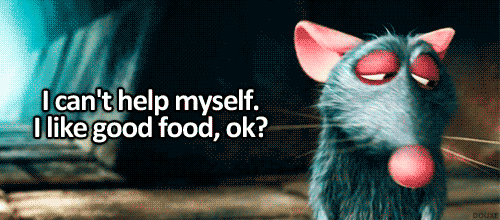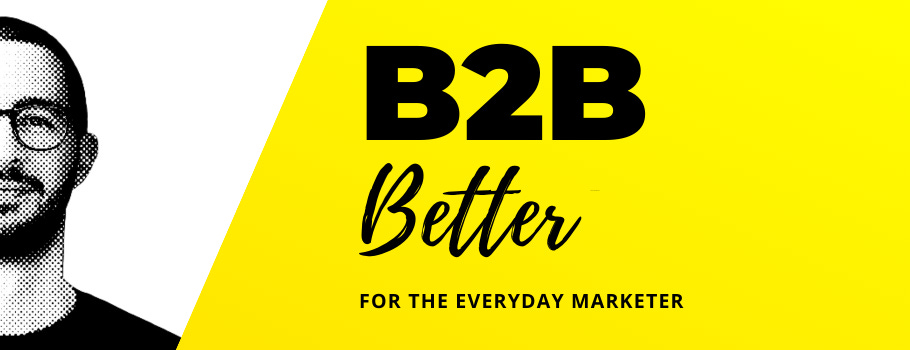🥤 What Do a Milkshake Bar and B2B Marketing Have in Common?
Also, I'm a foodie. There - my dirty little secret is out.
Hi! 👋
In The B2B Bite, I break down the most interesting marketing stories into fun-size, actionable chunks to kick off your week.
Sent every Monday AM. Best enjoyed with coffee.
Sign up below for free.
The Art of the Pivot
🥤 What Do a Milkshake Bar and B2B Marketing Have in Common?
I'm a foodie.
I know it's a cliche to say that, but it's true. I like to eat and I love to find places that will sell me food. On occasion, I will Instagram that food.
There’s this new place in my town called The Ducking Stool - a coffee shop that opened during the pandemic and has seen its business boom. Seriously, if you want to sample their delectable delights, be prepared to queue around the block.
On the other hand, here's another local eatery. It was called Tom's that came and went in under 12 months, not more than 2 minutes walk away from my new favourite cafe. They too offered hot drinks, but also cocktails and tapas-style dishes.
"Jason, why are you blathering on about this?" you're likely asking yourself.
Because the story of these two businesses - one a roaring success, the other an objective failure - holds a few important lessons for us B2B marketers.
Let me explain.
History
First, a bit of background about where I live, the quaint little English town of Christchurch:
According to TripAdvisor, there are a whopping 438 places to get something to eat or drink in the town of 50,000 or so people.
Lot's of families live here, but there's also a very high percentage of people aged 65+ - more than double the national average, actually.
Over the last few years, there has growing animosity over the number of coffee shops in the High Street. There's one every 36 yards or so.
Into this same context opened both The Ducking Stool and Tom's.
Both establishments - initially - were very similar. They were second businesses for their respective owners (a farmer and catering company owner, respectively). They both intended to serve food and drink at lunch and dinner. And they both were in more or less the same location.
Yet one failed within a year and shows every sign of becoming a High Street staple. Why?
What Changed?
Despite starting with the intention to become simply another eatery, The Ducking Stool was forced to adapt its plans in light of the pandemic. Eat-in dining simply wasn't on the table (ha - get it?), so owner Daniel Murray pivoted and started selling flavoured hot chocolate.
Yep. Having opened in the winter, Mr Murray doubled down on every child's favourite pre-bedtime drink, served with freshly whipped cream, an eco-friendly straw and delivered in a reusable flagon that lights up like a Christmas bauble.
Since then, he's added milkshakes to the menu as well, in anticipation of the summer months. And they do a ton of delightful flavours - check out their Facebook Page and let your mouth water like Niagara.
What's the Point?
Tom's failed because it did the same thing as a lot of B2B companies - nothing.
It started out with no immediately apparent unique selling point against the other 427 establishments in its market and, when it started to feel the strain, it remained rigid in its approach.
No meaningful change to its menu, no update of its decor, no investment in entertainment. Just more of the same.
This is where B2B organisations get stuck with their marketing. They look to their competitors, or what has worked for them in the past, and invest in the same approach - time and time again.
And when it doesn't work, they continue to double down, hopeful for a different result.
This, according to Einstein, is the definition of insanity.
Sometimes this is due to laziness. It's easy to sign a cheque to a trade publication each year in exchange for a 'Sponsored by' tag on their webinars. Or it can be due to resources and bandwidth. If you don't have the time/money to experiment, it's just safer to go with what you know.
But sometimes it comes down to a misunderstanding of the role marketing can play at a business level. If the attitude towards the function is that it's there to make things "look pretty" there will never be the motivation to take risks.
And that's why there will always be boring B2B.
🥡 Takeaway
For me, the team at The Ducking Stool has done a bunch of things right that would be well adopted by us B2B marketers.
They are memorable. There is no hot chocolate or milkshake bar in Christchurch other than The Ducking Stool. It is unique in that regard. For B2B companies, doing something that none of your competitors is doing is a USP by virtue of the fact that so few of them will take the risk of going against the crowd. Drift is a great example here. Instead of lumping itself in with every other marketing SaaS platform focussed on automation and scalability, the company coined the term "conversational marketing" to demonstrate the value of human-to-human interaction in sales.
They were comfortable pivoting. With the pandemic upsetting their plans for a more conventional eatery, the cafe had no choice but to embrace a new idea at short notice. In marketing, some ideas are good to start with but then run their course. Others never have much juice to begin with. Neither of these is a failure - they are learnings. Set clear objectives from the beginning with tangible milestones to hit along the way. Review and, if needed, adapt your strategy accordingly where you fall short.
They have focus. It's a symptom of poorly managed marketing teams trying to do everything at once. "Everyone's publishing daily to their blog - so should we!" "Everyone's starting a podcast - so should we!" "Everyone's doing video marketing - should we!" This is the fastest road to failure in content marketing. Instead, adopt the 60/20/20 rule; spend 60% of your time creating content for one channel, 20% of your time repurposing that content for everywhere else, and the final 20% exploring a channel your competitors aren't spending any time.
A hand-picked curation of some inspirational B2B stories I’ve come across this week.
Excellent tweet from Ian Barnard on creating custom marketing funnels that drive sales in B2B.
We all hope it never happens, but getting bad press is just part of this marketing life. Here are some tips on how to navigate a comms disaster.
There are few things I like more than free tools to make my job easier, so this list from Chantelle Marcelle is a goldmine.
Have you signed up to Marketing Mind Meld from Kushaan Shah yet? It’s one of my favourite newsletters on human psychology and our buying decisions.
And just in case you missed it from last week… 30 free B2B social media ideas from yours truly.
Every week, I share five nuggets of marketing wisdom from an expert in the field.
Here’s Simon Häger, Director of Marketing in the MedTech space, who gives his thoughts on social media success.
Put your customers and users into the spotlight and help them shine – that builds credibility. Praise their work on LinkedIn and Twitter.
Create engagement by adding some humour to your posts. Business should be fun and behind every tie, there is someone who likes to let loose.
People are smart; if you are only promoting your products, walls will go up and your customers may not believe you.
Write something personal about yourself. Most people like stories and when you open up, it creates engagement, credibility and compassion.
It is crucial to listen and learn from your customers and then analyze it together with other trends you see before you take action.
If you’d like to contribute to a future newsletter, you can send me a DM on Twitter.
…and here’s my podcast.
In my latest episode, I sit down with Masooma Memon, a freelance writer for SaaS companies.
We talk about whether a blog is right for every B2B company, what makes a blog post go from good to great and her tips for marketers who don't have someone dedicated to maintaining quality and consistency on their blog.
Masooma also talks about an exercise she runs to generate new ideas that reminds me of my time as an improv actor.
Previous episodes:
How to Use LinkedIn for More Than Just Lead-Gen w/ Charlie Whyman
What it Takes to Build a Successful B2B Community w/ Christina Pashialis
Tell Me Why… You Need Pop Culture in B2B Marketing w/ Brianne Fleming
Building a 10,000 Strong B2B Email List from Scratch w/ Sean Blanda
You can also find the B2B Better on Apple Podcasts and almost all other podcast directories.
And that's it! See you next week.










